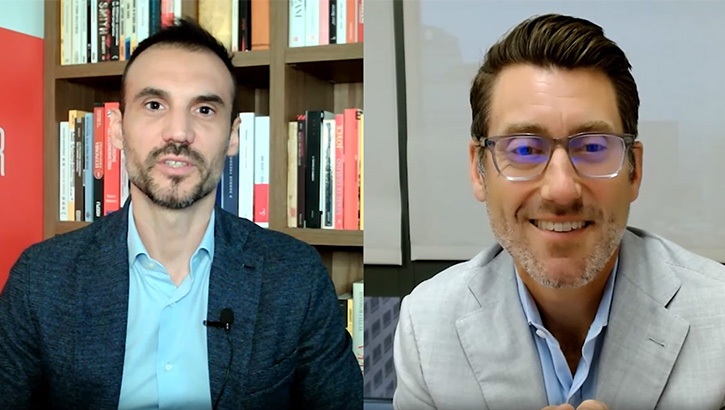This is the second article in series where we consider the applicability of the proposed Synthetic Risk Reward Indicator (SRRI) for the Key Investor Information document (KIID). Our first article, How Does Market Volatility Impact Risk Measure?, examined the benefits of using flexible cut-offs for the SRRI risk scores by linking the boundaries between scores to underlying market volatility. In this piece we consider the impact of currency risk.
Carving Up the Risk Pie
As it is commonly understood, the SRRI measures investment strategy risk, which, at a high level, can be decomposed into market risk (beta) and active risk (alpha). Of course, there are other risk factors that investors confront and need to deal with in financial markets. Certainly one of the bigger ones these days, as investors seek higher levels of diversification through broad geographic exposure, is currency risk. It is important for investors who buy assets in multiple currencies to understand that currency risk is distinct from investment strategy risk and that the SRRI does not, in fact, make this distinction. It simply measures the overall risk of the fund’s share class in the currency in which it is sold.
We will not dig too deeply into the characteristics of market and active risk in this article. Suffice to say, for most long-only investors, accepting market risk is the cost of entry--by investing in equities or bonds, directly or through managed products like mutual funds, investors are exposed to market risk. At the same time, most investors have a choice about how much active risk they are comfortable taking.
The practical trade-off with active risk is between the expectation of higher returns (usually accompanied by higher risk) and the certainty of higher costs (e.g. fees, taxes). As with any risk, investors must decide for themselves, or more probably work with a professional financial adviser to help them decide, whether they will be appropriately compensated for taking higher risks.
As Exhibit 1 below (risk and return on European funds for the five years ending January 2011) shows, the likelihood of riskier funds yielding higher returns can be quite small. For this reason, we argue that the second ‘R’ in SRRI be dropped from the name. Another good reason to drop “return” from the name is the SRRI only measures risk, in the form of volatility of the fund’s return, it does not reflect anything about the level of return of the fund.

The point is that risk is multi-dimensional. It is very difficult to distil the concept of risk down to a single figure such as the SRRI. While it is important to make concepts such as risk as simple as possible for investors to understand, it is equally important not to oversimplify. To quote Albert Einstein, “everything should be made as simple as possible, but not simpler.”
There and Back Again
As we mentioned earlier, currency risk can be a large risk factor for some investors. Consider an investor in the UK looking to invest in continental European stock or bond funds. At some point in the process, whether the investor realises it or not, her pounds will be converted into euros. Likewise, when she redeems her shares, the euros will be exchanged for pounds. This (sometimes not so) simple exchange brings with it risk that is not captured by strategy risk--this is currency risk.
To illustrate this point, we looked at the all equity, fixed income, and allocation funds available for sale in Europe with a base currency of euro that had a least a five-year history. Then we used the monthly spot rate to convert the return for these funds into pounds. After that we plotted each fund by its standard deviation in euro versus its standard deviation in pounds. See Exhibit 2 below (standard deviations of euro-based funds in euros and pounds, five years ending January 2011).

Notice the shape of this scatter plot. It looks a bit like a triangle--it has a broad distribution on the bottom left that tapers as it moves to the right. Take a close look at the bottom left area of this chart. Notice the low volatility euro funds (the x-axis) have standard deviations that cluster around 10% for the same fund once it is converted to pounds (y-axis). In fact, if you look at the table beneath the scatter plot you will see that 94% of the euro funds with SRRI scores of 1-4 would get a score of 5 if the currency were converted to pounds at the spot exchange rate (the fat lower left part of the chart). For the higher risk euro funds, the market and active risk factors are more dramatic, hence those funds are proportionally less affected by the currency conversion (the tapered upper right part of the chart).

Exhibit 3 above shows the actual standard deviation of a real fund for a share class based on euro and a pound share class. Clearly the risk return profiles for these two share classes are very different. Some portfolios may be hedged by policy or offer hedged share classes which will mitigate this effect. However, a currency hedge can never be perfect, so investors will still experience some currency risk.
How To Choose?
Now the question to invest in a hedged or non-hedged fund or share class depends on the investment objective and risk tolerances for each investor. Some investors may want to take the currency risk, others for sure won't. The point of this exercise is to demonstrate the pitfalls of trying to over-simplify the idea of risk. The idea of a single one-digit score is too simple to capture most of the big things investors need to understand about risks in investing.
Lastly, since the SRRI does not distinguish between different types of risk, it is of limited value in helping investors construct a diversified portfolio. If two funds have the same SRRI but are exposed to distinct types of risk, they can be combined to reduce risk. However, if they are exposed to the same risk factors, diversification will not reduce risk. We will take a closer look at this issue in our next article.






















